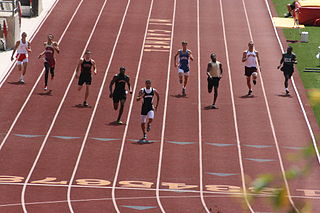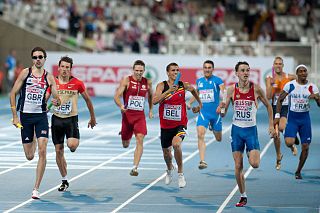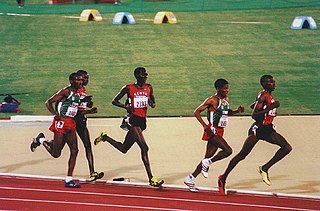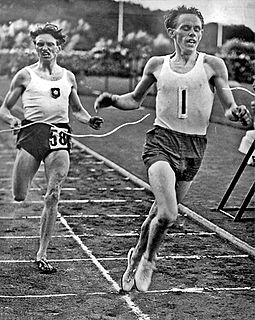
In Norse mythology, Rán is a goddess and a personification of the sea. Rán and her husband Ægir, a jötunn who also personifies the sea, have nine daughters, who personify waves. The goddess is frequently associated with a net, which she uses to capture sea-goers. According to the prose introduction to a poem in the Poetic Edda and in Völsunga saga, Rán once loaned her net to the god Loki.

The Royal Australian Navy (RAN) is the naval branch of the Australian Defence Force. Following the Federation of Australia in 1901, the ships and resources of the separate colonial navies were integrated into a national force, called the Commonwealth Naval Forces. Originally intended for local defence, the navy was granted the title of 'Royal Australian Navy' in 1911, and became increasingly responsible for defence of the region.

Ran(乱, Japanese for "chaos" or "turmoil") is a 1985 epic period drama film directed, edited and co-written by Akira Kurosawa. The plot derives from William Shakespeare's King Lear and includes segments based on legends of the daimyō Mōri Motonari. The film stars Tatsuya Nakadai as Hidetora Ichimonji, an aging Sengoku-period warlord who decides to abdicate as ruler in favor of his three sons.

The 800 metres, or 800 meters, is a common track running event. It is the shortest common middle-distance running event. The 800 metres is run over two laps of the track and has been an Olympic event since the first games in 1896. During indoor track season the event is usually run on a 200-metre track, therefore requiring four laps.

The 400 metres, or 400 metre dash, is a sprinting event in track and field competitions. It has been featured in the athletics programme at the Summer Olympics since 1896 for men and since 1964 for women. On a standard outdoor running track, it is one lap around the track. Runners start in staggered positions and race in separate lanes for the entire course. In many countries, athletes previously competed in the 440 yard dash (402.336 m)—which is a quarter of a mile and was referred to as the 'quarter-mile'—instead of the 400 m (437.445 yards), though this distance is now obsolete.

The 100 metres, or 100 metre dash, is a sprint race in track and field competitions. The shortest common outdoor running distance, it is one of the most popular and prestigious events in the sport of athletics. It has been contested at the Summer Olympics since 1896 for men and since 1928 for women.

The 200 metres is a sprint running event. On an outdoor race 400 m track, the race begins on the curve and ends on the home straight, so a combination of techniques are needed to successfully run the race. A slightly shorter race, called the stadion and run on a straight track, was the first recorded event at the ancient Olympic Games. The 200 m places more emphasis on speed endurance than shorter sprint distances as athletes predominantly rely on anaerobic energy system during the 200 m sprint.

The 4 × 400 metres relay or long relay is an athletics track event in which teams consist of four runners who each complete 400 metres or one lap. It is traditionally the final event of a track meet. At top class events, the first 500 metres is run in lanes. Start lines are thus staggered over a greater distance than in an individual 400 metres race; the runners then typically move to the inside of the track. The slightly longer 4 × 440 yards relay was formerly run British and American meetings, until metrication was completed in the 1970s.

60 metres, or 60-meter dash, is a sprint event in track and field. It is a championship event for indoor championships, normally dominated by the best outdoor 100 metres runners. At outdoor venues it is a rare distance, at least for senior athletes. The 60 metres was an Olympic event in the 1900 and 1904 Summer Games but was removed from the schedule thereafter.

60 metres hurdles is a distance in hurdling which is generally run in indoor competitions. It is equivalent with the first 60 metres including the first 5 hurdles of a standard outdoor hurdle race. The current women's and men's world records are 7.68 seconds and 7.30 seconds, respectively.
The 40-yard dash is a sprint covering 40 yards (36.58 m). It is primarily run to evaluate the speed and acceleration of American football players by scouts, particularly for the NFL Draft but also for collegiate recruiting. A player's recorded time can have a heavy impact on his prospects in college or professional football. This was traditionally only true for the "skill" positions such as running back, wide receiver, and defensive back, although now a fast 40-yard dash time is considered important for almost every position. The 40-yard dash is not an official race in track and field athletics and is not an IAAF-recognized race.

The 1500 metres or 1,500-metre run is the foremost middle distance track event in athletics. The distance has been contested at the Summer Olympics since 1896 and the World Championships in Athletics since 1983. It is equivalent to 1.5 kilometers or approximately 15⁄16 miles.

The 10,000 metres or the 10,000-meter run is a common long-distance track running event. The event is part of the athletics programme at the Olympic Games and the World Championships in Athletics and is common at championship level events. The race consists of 25 laps around an Olympic-sized track. It is less commonly held at track and field meetings, due to its duration. The 10,000 metre track race is usually distinguished from its road running counterpart, the 10K run, by its reference to the distance in metres rather than kilometres.

The 100 metres hurdles, or 100-meter hurdles, is a track and field event run mainly by women. For the race, ten hurdles of a height of 83.8 centimetres (33.0 in) are placed along a straight course of 100 metres (109.36 yd). The first hurdle is placed after a run-up of 13 metres from the starting line. The next 9 hurdles are set at a distance of 8.5 metres from each other, and the home stretch from the last hurdle to the finish line is 10.5 metres long. The hurdles are set up so that they will fall over if bumped into by the runner, but weighted so this is disadvantageous. Fallen hurdles do not count against runners provided that they do not run into them on purpose. Like the 100 metres sprint, the 100 m hurdles begins with athletes in starting blocks.

The 5000 metres or 5000-meter run is a common long-distance running event in track and field. It is one of the track events in the Olympic Games and the World Championships in Athletics, run over 12.5 laps of a standard track. The same distance in road running is called a 5K run. The 5000 m has been present on the Olympic programme since 1912 for men and since 1996 for women. Prior to 1996, women had competed in an Olympic 3000 metres race since 1984. The 5000 m has been held at each of the World Championships in Athletics in men's competition and since 1995 in women's.

The mile run is a middle-distance foot race.

Ran also known as GTP-binding nuclear protein Ran is a protein that in humans is encoded by the RAN gene. Ran is a small 25 kDa protein that is involved in transport into and out of the cell nucleus during interphase and also involved in mitosis. It is a member of the Ras superfamily.
The 1000 metres is an uncommon Middle-distance running event in track and field competitions.

The 2018 United States Senate elections were held on November 6, 2018. Thirty-three of the 100 seats were contested in regular elections while two others were contested in special elections due to Senate vacancies in Minnesota and Mississippi. The winners were elected to six-year terms running from January 3, 2019, to January 3, 2025. Senate Democrats had 26 seats up for election while Senate Republicans had nine seats up for election.
Ran Pethani railway station is located in Ran Pethani village, in Thatta district of Sindh province of the Pakistan.


















